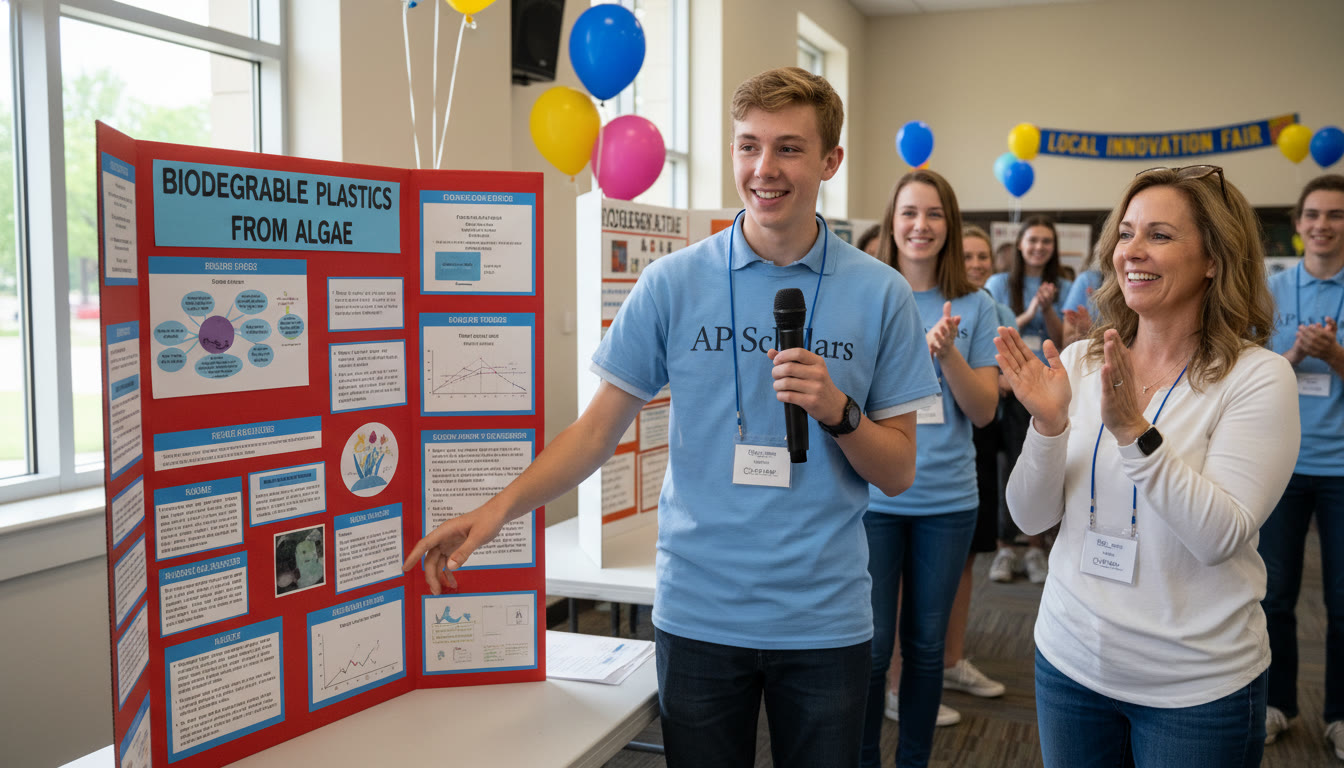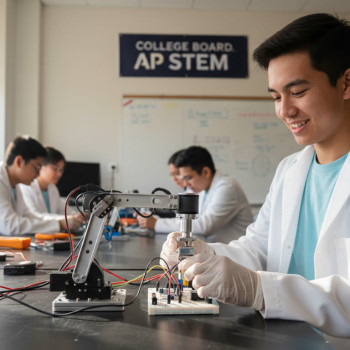The “Spike” Narrative: When Depth in AP Beats Shallow Breadth
There’s a story most parents hear in high school counseling offices: take as many AP courses as possible. It’s shared like conventional wisdom—good grades plus a long list of AP classes equals a stronger college application. But lately a different story has been gaining traction: the “spike” narrative. Instead of collecting every AP you can, students focus intensely on a smaller set of APs that match their interests, strengths, and future plans. The result? Real depth, demonstrable mastery, and a narrative colleges remember.

What Is a Spike—and Why Does It Matter?
A spike is a concentrated area of achievement and depth. In the context of APs, it means selecting a handful of subjects where your child can show advanced understanding, sustained commitment, and improvement over time. Instead of being a garden of many flowers, the spike is a tall, flourishing tree that stands out. Colleges and scholarship committees respond to that clarity: they like to see where a student has invested energy and what they’ve built.
Why does this matter to parents? Because the spike approach balances ambition with well-being. It helps students avoid burnout, develop meaningful expertise, and build a coherent academic story that aligns with personal interests and intended majors.
Depth vs. Breadth: A Practical Comparison
Let’s make the difference concrete. Below is a simple comparison to help you visualize the trade-offs parents and students face when choosing between breadth (many APs) and a spike (few, deep APs).
| Dimension | Breadth (Many APs) | Depth (Spike) |
|---|---|---|
| Academic Narrative | Wide-ranging, may appear unfocused | Clear, compelling, aligned with interests |
| Mastery | Surface-level in many areas | Strong, demonstrable in chosen subjects |
| Stress and Time | Higher risk of overload | More manageable, sustainable |
| College Credit/Placement | Possible across many subjects if scores are high | Likely deeper credit/placement in focused subjects |
| Extracurricular Fit | Harder to pair with meaningful ECs | Easier to build strong, related ECs |
When Breadth Still Makes Sense
To be fair, breadth isn’t always wrong. For students who are unsure about a future major, or who thrive on variety and can handle the workload without sacrificing sleep, sampling multiple APs can be a good way to explore. The key is intentionality: even a broad approach should have a purpose—sampling to confirm interest rather than a scattershot attempt to impress.
How to Decide: Questions Parents Should Ask
Decision-making is less about tallying APs and more about asking the right questions. Here are practical prompts you can use in conversation with your teen.
- What subjects excite you so much you’d happily read about them on weekends?
- Which subjects align with potential college majors or career ideas?
- How many demanding courses can your child reasonably handle without burning out?
- Are there opportunities to demonstrate depth outside class—research, internships, competitions?
- What does your high school counselor or teachers recommend based on your child’s performance and trajectory?
These questions move the decision from checklist-driven to values-and-capability-driven, which is crucial for long-term success and happiness.
Crafting a Spike: A Step-by-Step Plan
Here’s a practical five-step process parents can use to help their child build a meaningful AP spike.
1. Map Interests and Strengths
Start with honest conversation and evidence. Look at grades, feedback from teachers, and times when your child was genuinely engaged. A STEM-minded student who loves coding might spike in AP Calculus, AP Statistics, and AP Computer Science A. A budding historian could focus on AP U.S. History and AP World History, adding AP English Literature for writing strength.
2. Align With College Goals
If your child leans toward engineering, prioritize math and science APs. For those leaning to humanities or social sciences, focus on history, language, and writing-heavy APs. This alignment doesn’t lock your child into a major forever—colleges expect exploration—but it signals seriousness and coherence.
3. Choose Complementary Courses
Pick APs that reinforce one another. For example, AP Biology + AP Chemistry can support a future pre-med interest, while AP English Language + AP U.S. History supports strong analytical writing skills for humanities majors. Complementary APs build transferable skills—critical thinking, data analysis, argumentation—that serve across majors.
4. Build Supporting Experiences
Depth doesn’t live solely in the classroom. Encourage related extracurriculars: research projects, summer programs, community internships, or independent capstone work (AP Research is a great match for a spike approach). These activities make the spike tangible and show colleges a sustained commitment.
5. Use Focused Preparation
Deep prep is different from broad cram—students need structured, long-term study plans that prioritize conceptual understanding and application. This is where personalized tutoring can be a game changer: 1-on-1 guidance, tailored study plans, and expert tutors help students target weaknesses and deepen strengths without wasting time on irrelevant material. Tools that offer AI-driven insights can also pinpoint practice areas and track progress so study time is efficient and productive.
Study Strategies for Deep AP Mastery
Having a spike means you’re aiming for excellence, not just completion. These methods foster deep learning.
- Backward Planning: Start from the AP exam skills and design weekly milestones that build toward those skills.
- Active Retrieval Practice: Regular low-stakes quizzes and timed practice sections strengthen memory and exam technique.
- Interleaving: Mix problem types and topics across study sessions to build flexible knowledge.
- Writing to Learn: For humanities APs, practice timed essays and thesis-driven paragraphs often—quality over quantity.
- Formative Feedback: Seek detailed feedback on practice essays and projects; shallow grading won’t reveal where to improve.
Example Weekly Study Block for a Spike Student
Imagine a student focusing on AP Biology and AP Chemistry. Here’s a sample weekly plan that balances depth and recovery:
- Monday: AP Bio—concept review + 30-minute practice questions
- Tuesday: AP Chem—lab concepts + problem-solving set
- Wednesday: Writing practice—short synthesis paragraph linking Bio and Chem topics
- Thursday: Mixed practice—timed sections for both subjects
- Friday: Teacher or tutor session—targeted feedback and strategy
- Weekend: One extended practice test section + light review
How to Read the AP Course and Exam Descriptions
The College Board’s course and exam descriptions are the canonical guide to what each AP tests. They show the skills, course units, and exam format. For spike planning, use these documents to identify overlap across courses and to map high-yield topics that support both classroom learning and exam performance.
Parents don’t need to become content experts, but scanning the course descriptions with your teen will help you ask informed questions and support scheduling decisions.
Sample Two-Year Spike Pathways
Below are three illustrative two-year trajectories for different student types. These are templates; adjust them based on school offerings and the student’s readiness.
| Student Profile | Sophomore Year | Junior Year | Senior Year (Optional) |
|---|---|---|---|
| Future Engineer | Pre-AP Math/Physics, AP Computer Science Principles (if ready) | AP Calculus AB, AP Physics 1 | AP Calculus BC or AP Physics C; research project or internship |
| Budding Historian | AP Human Geography or honors history, AP English Language | AP U.S. History, AP World History | AP Seminar or AP Research, AP English Literature |
| Future Biologist | Honors Bio/Chem, AP Biology intro readings | AP Biology, AP Chemistry | AP Research, AP Statistics or another science elective |
Dealing with School Constraints and Realities
Not every school offers every AP, and scheduling conflicts are real. When your child can’t take a desired AP at their high school, consider these options:
- Dual enrollment at a community college (if available and appropriate).
- Self-study for the AP exam with a plan and external resources.
- Online AP courses through approved providers, ensuring they are authorized by the AP Course Audit if the school requires that.
If your teen chooses self-study, structured support—like focused tutoring—can bridge the gap: an experienced tutor can design a tailored study plan, model exam strategies, and provide accountability without the overhead of a full roster of classes.
Measuring Success Beyond AP Scores
A spike isn’t just high test scores. It’s evidence of intellectual curiosity, growth, and resilience. Here are meaningful indicators that your child’s spike is working:
- Improved depth of understanding as seen in projects, extended essays, or lab reports.
- Strong teacher recommendations that speak to curiosity and rigor.
- Related extracurricular achievements (research abstracts, competitions, community impact).
- Enhanced confidence and reduced burnout compared to trying to sprint through too many courses.
When to Recalibrate the Spike
Flexibility is important. Watch for these signs that it’s time to adjust the plan:
- Persistent decline in grades or mental health strain.
- The student discovers a new passion that warrants shifting course choices.
- Significant schedule conflicts that prevent meaningful engagement in chosen APs.
Recalibrating is not failure—it’s strategic parenting. A student who swaps one AP for a different one that better fits their emerging interests can create a stronger, more authentic narrative.
How Parents Can Support Without Taking Over
Support looks different from doing the work for your child. Effective parental involvement includes:
- Listening to your child’s goals and stressors and offering perspective without pressure.
- Helping set a realistic schedule and protecting sleep and downtime.
- Facilitating access to resources—practice exams, tutoring, or summer programs—when needed.
- Celebrating process milestones, not just exam outcomes.
When parents focus on structure and emotional support, students often show better resilience and performance. If you think targeted support would help, consider resources that offer personalized tutoring: 1-on-1 guidance, tailored study plans, expert tutors, and AI-driven insights can make study time more efficient and confidence-building.
Real-World Examples: What a Spike Looks Like
Example 1: Maya, future environmental scientist. She took AP Biology and AP Environmental Science across junior and senior year, completed a yearlong independent water-quality research project, and presented findings at a local science symposium. Maya’s application told a focused story and led to strong recommendation letters highlighting her scientific maturity.
Example 2: Alejandro, aspiring computer scientist. He dove into AP Calculus, AP Computer Science A, and followed that with a summer coding internship. He used AP classroom time to build a portfolio and wrote his college essay about a software tool he developed. Admissions officers saw him as a candidate with both skill and initiative.
Common Questions Parents Ask
“How many APs should my child take?”
There’s no magic number. Instead, aim for a balance: enough rigor to show commitment, but not so many that learning becomes shallow or that your teen is overwhelmed. For many students, 3–5 well-chosen APs across junior and senior years can be a productive spike.
“Should my child take every AP available in their subject area?”
Only if they can do so without sacrificing the quality of learning. Depth often trumps quantity. A student who takes AP United States History and follows it with independent research and strong essays will usually make a more memorable case than a student who spreads across six APs without standout work.
“What role can tutoring play?”
Tutoring is most effective when it’s personalized. Tutors who create tailored study plans, target weak spots, and simulate exam conditions help students move from comprehension to application. Services that combine expert tutors with analytics can accelerate improvement and preserve time for other pursuits. When chosen thoughtfully and used strategically, tutoring supports the spike—it doesn’t replace student effort; it amplifies it.
Final Thoughts: Make the Spike Your Story
Raising a teenager in the AP era is an exercise in discernment. The spike narrative reframes the conversation from “How many APs can we take?” to “Where should we invest, and what will that investment look like?” Depth offers students a chance to become known for something meaningful. It creates space for rich learning, intellectual identity, and sustainable success.
As a parent, your most powerful role is to be a thoughtful partner: ask smart questions, protect balance, and help your child find scaffolding when they need it. Whether that scaffolding is a teacher, a summer program, or personalized tutoring with 1-on-1 guidance and tailored study plans, the goal is the same—help your child learn deeply, show their best work, and enjoy the process.

Choose the path that lets your child be curious, committed, and human. In the end, a well-crafted spike—backed by thoughtful planning and the right support—tells a clearer, more compelling story than a transcript that merely lists a dozen unchecked boxes. That’s the kind of narrative that colleges notice and the kind of learning that lasts.
Ready to help your child build their spike? Start with a conversation this week: ask about interests, map classes that match, and consider a tailored study plan that preserves balance while pushing for real depth.



















No Comments
Leave a comment Cancel